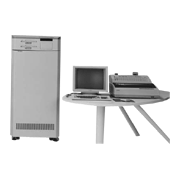This was an AI workstation which came into being in 1986 when Mitsubishi Electric commercialized the personal sequential inference machine (PSI) developed under the leadership of the Institute for New Generation Computer Technology (ICOT), as part of the Fifth Generation Computer Project which began in 1982.
The PSI's system description language was ESP (Extended Self Contained Prolog), a language which added object-oriented functionality (to enable hierarchical expression of knowledge and program modularization) to Prolog, a programming language with inference capability based on trial-and-error (backtracking). The PSI was developed to execute this language at high speed. Therefore, the PSI hardware directly executed KL0 (Fifth Generation Kernel Language Version-0), a machine language with the same structure as Prolog.
The variables handled by Prolog are identified as defined or not, and data types vary dynamically, so memory addresses were comprised of 40 bits: a 32-bit data field, plus an 8-bit tag for indicating defined or not and the data type. Also, the logical space was divided into independent segments called areas, and allocating one stack to each area made it possible to use multiple stacks, thus facilitating backtracking and dynamic creation of complexly structured data. The higher order 8 bits of the 32-bit physical address were used for area identification.
The PSI main memory was a maximum of 16M words (80MB). The CPU had 8K words of cache memory, and machine cycle time was 200ns.
The operating system of PSI, called SIMPOS (Sequential Inference Machine Programming & Operating System), had user-friendly operation based on multiple windows, a set of development tools with powerful capabilities, and a wealth of library functions. SIMPOS itself was described in ESP, and thus the overall capabilities of the system could be easily used from within user programs. EXTKERNEL, an expert system shell for improving system development efficiency, was also provided.
A desk-side model called the PSI II, with over 3 times the performance, was announced in 1987. For the PSI II, the functionality of EXTKERNEL was enhanced, and the ACEKIT knowledge spread sheet with inference capability was provided as a user interface.


